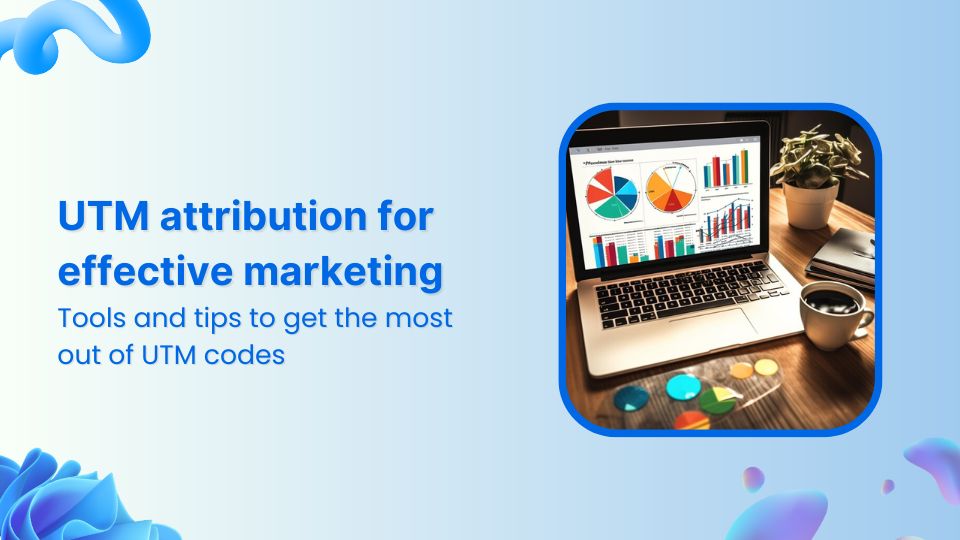With so many channels and touch-points in play, figuring out what really drives conversions can feel like a puzzle. That’s where UTM attribution comes in handy.
But what exactly are UTMs, and why should marketers care?
We’ll tell you why!
Let us break it down for you this way. Each UTM parameter—like source, medium, campaign, term, and content—gives a crystal-clear picture of how users engage with your content.
- Did that email newsletter seal the deal?
- Was it the social media ad, or maybe that fresh landing page on your site?
UTMs hold all the answers. By the end of this guide, you’ll understand UTM attribution like a seasoned marketer. Whether you’re optimizing PPC ads, tracking email campaigns, or measuring the impact of that quirky TikTok video, UTMs will be your trusty sidekick.
What are UTM codes?
UTM codes are snippets of text appended to URLs that provide granular data on how users find your website. By strategically adding these codes to your marketing materials (emails, social media posts, etc.), you gain valuable insights into which channels, campaigns, and even specific ads are driving the most traffic and leads.
Why do you need to capture the source of every lead?
Understanding lead sources allows businesses to tailor their marketing messages to specific audiences. For instance, leads from social media might respond better to informal content. While those from a webinar sign-up might be interested in in-depth information.
Besides that tracking lead sources helps businesses identify areas for improvement. They can see which campaigns are generating leads and adjust their approach accordingly.
Also by filtering down high-performing channels, brands can maximize their return on investment (ROI) for marketing efforts.
Getting Started with UTMs:
Adding UTM codes to your URLs is a straightforward process. While various online tools can help with this, the core components one needs to keep track of include:
- utm_source: This identifies the origin of your traffic (e.g., Facebook, email_newsletter)
- utm_medium: This specifies the marketing channel (e.g., social_media, email)
- utm_campaign: This defines the specific campaign name (e.g., summer_sale)
- utm_content: It allows you to differentiate between different versions of the same ad or content.
- utm_term: This parameter is primarily used in paid search campaigns to specify the keywords that triggered the ad.
Remember, clear and consistent naming conventions for your UTM parameters are crucial for accurate data analysis.
7 tips to get the most out of UTM codes
By understanding where your website traffic originates, you can optimize campaigns, refine strategies, and maximize your return on investment (ROI). But simply adding UTM codes isn’t enough.
To truly get the most out of them, follow these UTM best practices:
1. Consistency is king
Treat UTM codes like your loyal subjects – keep them consistent! Inconsistent naming conventions across campaigns lead to fragmented data, making it impossible to see the bigger picture. Develop a clear naming structure for each UTM parameter (source, medium, campaign, etc.) and stick to it religiously.
2. Tag, Tag, Tag!
Don’t underestimate the power of a well-placed UTM code. Tag every single link that could potentially drive traffic to your website, not just display ads or email blasts.
This includes social media posts, organic search results (use UTM parameters with caution here to avoid penalization by search engines), QR codes, and even links within your email signature.
3. Descriptive details matter
Don’t settle for generic terms like “email” or “social media” in your UTM parameters. Use descriptive terms that paint a clear picture. Was it a “welcome email” or an “abandoned cart” email that drove traffic?
For social media, specify the platform (e.g., “Twitter”) and potentially the content type (e.g., “video-tweet”). The more granular your details, the more insightful your data will be.
4. Less is more (sometimes)
While descriptive details are important, avoid creating UTM codes so lengthy they become unwieldy. Focus on capturing the most crucial details – campaign name, source, and possibly medium.
Reserve the “content” and “term” parameters for situations where additional nuance is absolutely necessary.
5. Befriend the lowercase letter
UTM codes are sensitive to case distinctions. So prioritize the use of lowercase letters to avoid data fragmentation and maintain consistency. Remember, “Facebook” and “Facebook” will be identified as distinct sources in your analytics platform.
6. Utilize a UTM tool may be
Building UTM codes manually can be tedious and error-prone. Fortunately, there are numerous free and paid UTM code generators available. These tools streamline the process, allowing you to quickly generate UTM codes based on your campaign specifics.
7. Never add UTM parameters within internal links
UTM codes are fantastic for tracking external traffic sources, but they can clutter your internal website data. Refrain from adding UTM codes to links that direct users to different pages within your own website. This can skew your website analytics and make it difficult to understand user behavior on your site.
Related: More UTM best practices & tips
UTM parameters for traffic attribution
Now that we’ve covered the basics of UTM parameters, let’s get into some technicalities. For that you need to understand that UTM attribution serves two primary purposes:
- Traffic attribution
- Marketing attribution
What is traffic attribution?
Traffic attribution is identifying the source and origin of your website visitors. It helps you understand which marketing channels (social media, email marketing, search engine ads, etc.) are driving traffic to your site.
Why use UTM parameters for traffic attribution?
UTM parameters are snippets of text added to the end of your website URLs. They provide valuable analytics of your marketing campaigns, allowing for more granular traffic attribution. Here’s why you should use UTM parameters for traffic attribution:
- Accurate attribution: By using UTM tags, you can pinpoint exactly where your traffic originates from, giving credit to the most effective marketing channels. This prevents over- or under-investment in particular channels based on misleading data. You can see which campaigns generate the most clicks, conversions, and overall engagement.
- Quick ROI calculation: Knowing which channels bring in the most conversions allows you to calculate the Return On Investment (ROI) of your marketing efforts. This helps you understand which channels deliver the best value for your budget.
- Segment your audience: UTM parameters allow you to segment your website visitors based on their traffic source. This lets you tailor your website content and messaging to specific audiences for a more personalized experience.
Common attribution models
| Attribution models | Attribution models description |
|---|---|
| Last click attribution | This assigns credit to the last channel a user interacted with before converting. |
| First click attribution | This credits the very first channel a user interacted with on their conversion journey. |
| Multi-touch attribution | This acknowledges that users often interact with multiple channels before converting, and assigns credit proportionally across those touchpoints. |
| Linear attribution | This model distributes credit for a conversion equally across all channels a user interacted with before converting. |
| Time decay attribution | This model assigns a predetermined percentage of credit to each touchpoint based on its position in the customer journey. |
| Position-based attribution | This model assigns more weight to touch-points closer to the conversion and gradually reduces credit for earlier interactions. attribution |
You may also like: Conversion tracking: Best tools, tips, and tricks
What is marketing attribution?
Marketing attribution is the process of identifying the specific sources and channels that influence a customer’s journey towards conversion.
How to use UTM parameters for marketing attribution?
Here are the primary scenarios where UTM attribution is commonly utilized:
- Campaign insights
Let’s say you’re running different Facebook ad variations promoting a new product. By using UTM parameters with different utm_content values for each variation, you can track which ad resonates best with your audience, leading to more clicks and conversions.
- Keep an eye on your CPA (Cost Per Acquisition) and ROAS (Return on Ad Spend)
Watch your spending! Track how much it costs you to get each customer (CPA) and how much revenue you make from your UTM-tagged ad campaigns (ROAS). Lowering your CPA while boosting your ROAS means you’re getting more bang for your buck. It’s like balancing your checkbook – aim to spend less and earn more to keep your marketing efforts profitable.
5 reasons to invest in UTM attribution
UTM attribution sheds light on the effectiveness of individual campaigns, channels, and even specific content pieces. You can see which initiatives generate the most conversions (sales, sign-ups, etc.), allowing for precise ROI calculations. Here are some other reasons why you should invest in UTM attribution.
1. See the full picture of your customer’s journey
Let’s face it: the path to a purchase is rarely straightforward. UTM attribution helps you untangle the web of touchpoints that lead to conversions, showing you how different channels work together to guide customers along the way. Armed with this knowledge, you can fine-tune your approach to nurture leads and create a smoother journey for your customers.
2. Quick A/B testing
UTM parameters enable you to conduct A/B testing efficiently. By assigning unique UTM tags to different versions of your marketing materials (landing pages, email campaigns, ad variations), you can track which version performs better in terms of traffic and conversions.
Related: A/B Testing Benefits, Examples & Other Factors To Consider
3. Improved reporting and communication
By consolidating data from different marketing channels into one platform, UTM attribution tools provide a centralized view of your marketing efforts. This eliminates the need to gather data from multiple sources manually, streamlining the reporting process.
4. Saves time and resources
Instead of manually tagging URLs and analyzing data, UTM attribution tools do the heavy lifting for you, saving you time and reducing the chance of errors. Also, these tools UTM offer features such as customizable dashboards and reports, making it easy to quickly analyze campaign performance. With clear visualizations and insights readily available, marketers can make informed decisions faster, saving time on manual data analysis.
5. Future-proof your marketing strategy
With UTM attribution you can make reports that show how well your marketing is doing. This helps you and your team understand what’s working and what needs to change. In easier words, you can identify hidden gems and avoid wasted resources.
3 best UTM tools
1. Usermaven
Usermaven isn’t just another UTM analytics tool – it’s on top of the ones that truly stands out. Why? Because it’s packed with features that give you real insights into how your campaigns are performing. From tracking in real-time to breaking down your audience into segments, it’s got everything you need to take your marketing game to the next level.
One of the coolest things about Usermaven is its UTM tracking feature. This lets you see exactly where your traffic is coming from. Whether it’s from emails, social media posts, or ads, Usermaven helps you track it all. And with parameters like source, medium, campaign, term, and content, you get a complete picture of what’s working and what’s not.
But that’s not all. Usermaven lets you track every step of your customer’s journey, so you can see exactly how they go from browsing to buying. Users can also set attribution windows, such as 30 days or 60 days, to align with their sales cycle and accurately attribute conversions to the appropriate marketing channels.
Additionally, the platform offers various attribution models, including first touch, last touch, linear, and position decay, allowing marketers to analyze the customer journey from different perspectives and optimize their campaigns accordingly.
Key features:
- Multi-touch attribution
- Audience segmentation
- Real-time conversion tracking
- Advanced reporting and analytics
- Detailed funnel analysis
- Automated and custom event creation
- Integration with popular marketing platforms
- Collaborative features for team workflow
But here’s the best part: Usermaven isn’t just for big businesses with big budgets. Its pricing structure is super affordable, so whether you’re a one-person shop or a growing enterprise, you can access its powerful features without breaking the bank.
Related: How to track UTMs in Usermaven
2. Replug
Replug is another excellent UTM building tool. It allows you to create shortened URLs with UTM parameters, making them more manageable and easier to track.
When marketers create branded short links using Replug, they have the option to include UTM parameters such as source, medium, campaign, term, and content. This ensures that every link shared through Replug is properly tagged with UTM parameters, allowing marketers to track the effectiveness of their campaigns with precision.
Additionally, Replug offers customizable call-to-action overlays for links, making it easy for marketers to drive engagement and conversions.
The best part? Replug offers both free and paid versions of the UTM building feature. Try now!
- Branded short link creation
- Quick and easy UTM generation
- Call-to-action overlays for link optimization
- Real-time link tracking and analytics
- Lead capture and retargeting capabilities
- Advance white-label boards
- Deep link, link rotation, SMS links
3. TerminusApp
TerminusApp is a versatile UTM management platform that helps you organize and track your marketing campaigns. It allows you to create custom UTM tags, ensuring consistency across different channels.
With TerminusApp, you can effortlessly manage UTM parameters, ensuring accurate attribution and better insights. Whether you’re running social media ads, email campaigns, or affiliate marketing, TerminusApp simplifies the process of UTM tagging and tracking.
8 Common mistakes to avoid with UTMs
| Sr. | Common Mistakes | Description |
| 1. | Not using a URL shortener | Long, unwieldy URLs with UTMs can be error-prone and messy. Opt for URL shorteners to maintain cleaner, more manageable links. |
| 2. | Missing or Incomplete parameters | Don’t leave any gaps in your data. Ensure all three core UTM parameters are included in your tagged URLs. |
| 8. | Ignoring data hygiene | Clean up any duplicate entries or incorrect tags to maintain data accuracy and avoid skewed insights. |
| 3. | Forgetting to test your tags | Before launching your campaign, test your UTM-tagged URLs in your browser to ensure they function correctly and display the intended parameters. |
| 4. | Not updating UTM tags for ongoing campaigns | As your campaigns progress, update UTM tags if necessary to reflect changes in the source, medium, or specific details. This ensures consistent data collection throughout the campaign duration. |
| 5. | Using UTMs to track internal links | UTMs are primarily for external campaigns (social media, email, etc.). Avoid using them for internal navigation within your website. |
| 6. | Filling in the term UTM with non-keywords | The utm_term parameter is often misunderstood. It’s intended for paid search keywords, not generic terms. Use keywords accordingly. |
| 7. | Overcomplicating your tags | While UTMs offer flexibility, avoid creating overly complex tags that are difficult to understand or manage. |
Conclusion
UTM attribution may seem like a technical detail, but it holds immense power for savvy marketers. By strategically employing UTM codes, you can open up the door to accurate and accessible data that reveals what truly drives traffic, conversions, and ultimately, success for your brand.
Remember, consistent application and clear naming conventions are key to unlocking the full potential of UTMs. With the insights gained, you can fine-tune your marketing strategies, optimize campaigns across channels, and maximize your return on investment. So, take control of your marketing data today with UTM attribution, and watch your campaigns flourish!
FAQs
What are UTM codes, and how do they work?
UTM codes are snippets of text appended to URLs that provide detailed data on how users find your website. They consist of parameters such as source, medium, campaign, term, and content, allowing you to track the effectiveness of your marketing efforts.
What are the primary benefits of using UTM parameters?
UTM parameters offer several benefits, including granular tracking of traffic sources, insights into campaign effectiveness, ROI calculation, audience segmentation, and the ability to conduct A/B testing.
Can UTM parameters be used for tracking email marketing campaigns?
Yes, UTM parameters are commonly used to track the performance of email marketing campaigns.
Do UTM parameters impact website loading speed?
UTM parameters themselves have minimal impact on website loading speed. However, excessively long URLs with numerous UTM parameters may slightly increase load times.


































